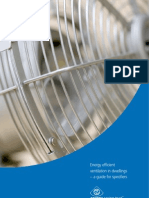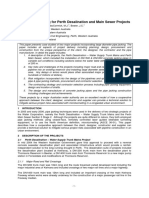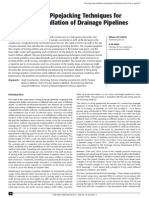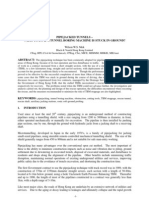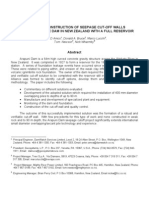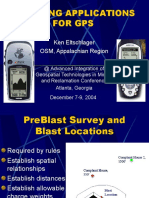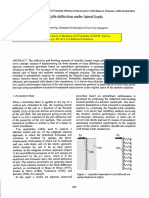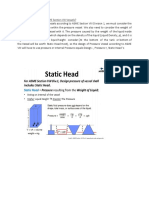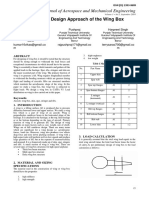Behrens
Behrens
Uploaded by
Tony ChanCopyright:
Available Formats
Behrens
Behrens
Uploaded by
Tony ChanOriginal Description:
Copyright
Available Formats
Share this document
Did you find this document useful?
Is this content inappropriate?
Copyright:
Available Formats
Behrens
Behrens
Uploaded by
Tony ChanCopyright:
Available Formats
HOME
Steel Immersed Tube Tunnels where Tunnel Boring
Machines Cannot Operate Yarra River Crossing
Construction on the Melbourne Main Sewer
Replacement Project
M Behrens1, D Wilcockson2 and M Hashim3
ABSTRACT
The Melbourne Main Sewer Replacement (MMSR) is a major urban infrastructure project involving
approximately 2.3 km of tunnelling and construction works. The works extend from Docklands
Precinct, on the southwest edge of the city, southwards to connect with the Hobsons Bay Main Sewer
in Port Melbourne. The tunnel boring machine (TBM) tunnelled section of the works terminates at the
Yarra River where the delta geology and alignment requirements precluded the use of underground
tunnelling methods. The 132 m long river crossing works involve a cut-and-cover excavation within
a staged flooded cofferdam construction to construct an immersed tube tunnel as an extension of the
TBM works.
This paper reports on the development of the staged construction method and highlights the
geotechnical and structural design aspects involved in building a new sewer in the Yarra River to
close the gap between the new TBM driven and pipe-jacked tunnels.
INTRODUCTION
The Melbourne Main Sewer Replacement (MMSR) is a major sewerage system renewal project for
Melbourne Water replacing an existing sewer that is over 100 years old. The existing sewer consists
of a variety of materials including brick ovoid, concrete block work and concrete lined cast iron sewer
sections. The new 1.8 m internal diameter (ID) lined sewer construction involves approximately
2.1 km of tunnel boring machine (TBM) tunnelling, 132 m of trenched pipeline and 30 m of 1.5 m ID
pipejacking.
A major component of the MMSR is the works associated with crossing the Yarra River a short
distance upstream of the Charles Grimes Bridge (Wurundjeri Way). The works connect the TBM
receival shaft (south bank) and the pipe-jack receival shaft (north bank). The 132 m long river
crossing works will be completed using a staged flooded cofferdam construction method within the
weak alluvial sediments associated with the Yarra River delta geology.
The project works are being constructed by John Holland with the support of Halcrow as
construction temporary works engineer. Permanent works designer for Melbourne Water is GHD.
The construction contract is a cost reimbursement-profit share type, as part of the Preferred
Tunnelling Contractor agreement between John Holland and Melbourne Water. The agreement
promotes designer/contractor co-operation in the development of the permanent works to achieve
the project functional requirements.
CONSTRAINTS
The design and construction of the temporary works required that several challenges be addressed.
These included:
Yarra River delta geology consisting of extremely weak river sedimentary units with low and
highly variable shear strength, along with recently deposited silty sediments which are highly
1. Project Technical Manager (Melbourne Main Sewer Replacement Project), Halcrow Pacific Pty, Level 1, 542 Station Street, Box Hill Vic 3128. Email: behrensm@halcrow.com
2. River Crossing and Shafts Manager (Melbourne Main Sewer Replacement Project), John Holland, 2/283 Normanby Road, Port Melbourne Vic 3207. Email: david.wilcockson@JHG.com.au
3. Senior Engineer, Halcrow Pacific Pty, Level 1, 542 Station Street, Box Hill Vic 3128. Email: hashimm@halcrow.com
14TH AUSTRALASIAN TUNNELLING CONFERENCE / AUCKLAND, NEW ZEALAND, 8 - 10 MARCH 2011
29
M BEHRENS, D WILCOCKSON AND M HASHIM
susceptible to river bed scour and erosion. These sediments have negligible strength and occupy
the upper 2 - 3 m of the river bed, having accumulated since dredging stopped in the 1980s.
The risk of causing environmental damage by the release of potentially contaminated silt plumes,
from historic riverside industry, was required to be addressed for both the permanent and
temporary works river crossing construction.
The risk of river embankment flooding, particularly upstream in the city precinct, in the case of a
one in 100 year flood event was to be addressed in the staging of the crossing temporary works.
Detailed flood studies were completed to demonstrate the minimisation of this risk.
Access to the river for community use was to be maintained by keeping at least two-thirds of the
river width open to water-borne traffic during construction.
Site space restrictions for construction plant and equipment due to the presence of major urban
roads and bridges at either end of the crossing. This included the concurrent construction of
the Melbourne Convention Centre on the south embankment where a TBM retrieval/river works
connection shaft was required.
The sewer alignment, particularly vertical alignment with the invert located at approximately RL
-9.20, was restricted by hydraulic requirements. This resulted in river bed excavation depths of
between 7 - 11 m.
SCHEME DEVELOPMENT
The permanent works design at the time of tender involved a sewer construction consisting of 1.8 m
internal diameter (ID) glass reinforced polymer (GRP) liner encased with mass concrete. The works
were proposed to be constructed within sheet piled temporary works.
A series of workshops and optioneering reviews for the temporary/permanent works construction
methodology were completed involving John Holland and Halcrow staff to develop the most feasible
functional construction scheme for the river crossing. Different options for sheet pile cofferdam
construction, both drained and flooded, were reviewed in terms of risk management, cost, time
period of construction, construction methodology, etc.
A drained cofferdam option involving a wall system of combined sheet and H-piles was rejected
due to the weak geology in the embedment zone and the requirement for very long (~30 m) sheet/
piles. Difficulties associated with this option included steel pile handling and the risk of extraction
failure, multiple levels of heavy temporary propping, risk of foundation failure and high construction
cost and risks (eg flooding).
Ultimately, a flooded cofferdam temporary works solution was adopted. The key advantages were
a greater economy in total steel use, reduced sheet pile embedment making piles recoverable, and
reduced construction risk.
An alternative form for the permanent works was developed with input from all parties and
accepted by Melbourne Water. It involved a change from a mass concrete encased sewer to a sewer
built within an immersed steel tube supported on pile bents at regular intervals.
The final construction methodology and details may be summarised as:
A modular flooded cofferdam method of temporary construction whereby the majority of
structural elements could be reused potentially up to three times.
Steel sheet piles, to form a joined pair of rectangular cells, supported by a system of steel walers,
struts and tension members at the top above river high tide level.
Use of immersed steel tubes (carrier pipes) installed as temporary/permanent works, to be lined
with GRP liner pipes, in place of a mass concrete surround.
Connection between carrier pipe lengths via a bolted flange and sealed with hydrophilic gaskets
to limit inflow and enable liner installation at a later stage.
A support system for carrier pipes involving a pair of U-shaped precast concrete headstocks,
clamped together around the pipe to restrain buoyancy effects, supported on tubular piles. The
piles are designed for long-term support and settlement limitation.
A simple slip-resistant connection system on the tubular pile for the temporary support of the
lower precast headstock unit in its underwater position until the cast-in situ concrete headstockpile connection was constructed.
14TH AUSTRALASIAN TUNNELLING CONFERENCE / AUCKLAND, NEW ZEALAND, 8 - 10 MARCH 2011
30
STEEL IMMERSED TUBE TUNNELS WHERE TUNNEL BORING MACHINES CANNOT OPERATE
Additional advantages of the above system are:
all structural elements (permanent and temporary) are modular, can be transported by road and
their weight is suitable for the barge mounted crane lifting capacity of 25 tonnes, as governed by
barge overturning stability;
simple structural assembly underwater of permanent works via a limited number of bolted
connections and in situ concrete stitch pours;
simple two-part precast concrete headstock to support the carrier pipe can be installed underwater;
and
the GRP liner can be installed in a dry environment within the carrier pipe in the same manner
as the TBM tunnel.
The variations to the permanent works design were subsequently worked through to final
construction by GHD, with continued consultation with the contractor and temporary works
designer. As a result, the new sewer involves a 2.4 m ID 32 mm thick steel carrier pipe with 1.8 m ID
GRP/concrete secondary lining. The pipes are supported on precast concrete headstocks and pairs
of 457 mm OD steel tubular piles at approximately 4.9 m centres.
With the adoption of a sheet piled solution for the river crossing temporary works, the temporary
connection shafts at the river embankments were to be constructed with steel waler framing and the
same sheet pile size.
RIVER BED GEOLOGY
The river bed geology comprises recently deposited silty sediments overlying 6 - 10 m depth of Coode
Island silt (CIS), 13 - 14 m depth of Fishermens Bend silt (FBS), followed by the Moray Street Gravel
unit (MSG).
The geotechnical parameters were derived from both laboratory and in situ soil measurement test
data from cone penetrometer testing. The test data demonstrated the interlaced nature of the silts
and sandy silts and significant material variations within the interpreted geological units and across
the river width.
Of significance to the cofferdam works design are the low undrained shear strengths of the silty
clays. Within the CIS unit, between approximately RL 0.00 to RL -12.00, shear strengths ranged
from 10 - 30 kPa and within the FBS unit shear strengths ranged from 10 - 100 kPa. The majority
of geotechnical and geological data was provided in the MMSR Project Geotechnical Factual Report
(GHD, 2007).
For temporary works design purposes an assessment of all the data was completed to obtain the
lower and upper bound values for geotechnical parameters. Lower bound parameters were adopted
in the design to account for the construction risks associated with foundation material variability
along the alignment. These risks included the potential for structure system/foundation failure and
construction delays should remedial measures be required.
COFFERDAM STRUCTURAL SYSTEM
The cofferdam structural system consists of embedded cantilever sheet pile walls (AZ41 - 700
sections) propped at the top with a support system of waler and strut/tie frames. Overall geometry
required an internal clear width of 6.1 m to account for piling tolerances and adequate working
space. Figure 1 shows the adopted cross-section geometry.
The overall length of the construction is 132 m between the river bank shafts. The construction of
the crossing is being completed in three main stages (Stages 1, 2 and 3), each with a length in the
range of 45 - 50 m as shown in Figure 2. Each stage is divided into two substages (Cells A and B)
allowing each cell to be used for spoil containment during excavation of the adjacent substage.
Structural/geotechnical analysis of the temporary works system was carried out with detailed
consideration of the construction staging sequences, construction risks and potential contingency
measures, and variability of foundation materials to ensure the system remained stable.
Given the weak foundation soils and their influence on system stability, the risk of base heave
failure in the soft soils was carefully assessed. A series of closed form empirical stability analyses
(Uktritchon, Whittle and Sloan, 2003; Bowles, 1997) were completed and compared with finite
14TH AUSTRALASIAN TUNNELLING CONFERENCE / AUCKLAND, NEW ZEALAND, 8 - 10 MARCH 2011
31
M BEHRENS, D WILCOCKSON AND M HASHIM
FIG 1 - Cross-section of temporary and permanent works for Melbourne Main Sewer Replacement river crossing.
element analysis using PLAXIS and the factors of safety against base heave and overall overturning
stability were found to be in excess of 2.0.
The structural propping system (internal support frame) for the cell excavation phase consisted of
three modular steel waler and strut frames using 350WC197 rolled sections see Figure 3.
External walers (back to back 300 PFC) were erected on the outside face of the cofferdam and
connected using 32 mm diameter tie rods for the cell fill phase. Transverse bulkheads (AZ41 - 700
piles) were installed at Stage ends and between every substage. A special type of modular steel portal
frame was installed at RL -2.80 as support to enable the sheet pile bulkheads to be cut and removed
for floating the carrier pipe into position.
For ease of construction, the strut positions in the modular support frames were primarily
arranged so that the permanent works tubular support piles and precast concrete headstock could
be installed between two struts. The struts were designed as removable members which could easily
be repositioned if required. This contingency allowed for positional interference between support
framing and permanent works installation positions in case pile creep occurred on the subsequent
cofferdam stages. Bolted structural steel frames, rather than welded connections, were preferred due
to the simplicity and speed of erecting/disassembling bolted connections over and underwater.
CONSTRUCTION SEQUENCE
The temporary and permanent works construction sequence is described below considering Stage 1
as an example (refer to Figure 4).
Initially the sheet piles, some with monitoring inclinometers attached, were pitched and vibrated/
driven to depth along and perpendicular to the alignment at the north end (bulkhead) to form the
14TH AUSTRALASIAN TUNNELLING CONFERENCE / AUCKLAND, NEW ZEALAND, 8 - 10 MARCH 2011
32
STEEL IMMERSED TUBE TUNNELS WHERE TUNNEL BORING MACHINES CANNOT OPERATE
FIG 2 - Plan layout of works stages.
FIG 3 - View of cofferdam internal propping system Stage 1.
14TH AUSTRALASIAN TUNNELLING CONFERENCE / AUCKLAND, NEW ZEALAND, 8 - 10 MARCH 2011
33
M BEHRENS, D WILCOCKSON AND M HASHIM
FIG 4 - Construction sequence for Stage 1 works.
cofferdam. The south end of cofferdam was formed by the end wall of sheet piled shaft. It was divided
into substages 1A and 1B by a full depth sheet pile bulkhead near mid-length.
The internal support frame was installed within both cells and the external walers and tie rods
were installed for Stage 1B since this cell became the fill-cell during the initial excavation. River
bed excavation commenced in Stage 1A with the spoil being placed into Stage 1B up to a maximum
spoil level at RL 0.0. After the required excavation depth was reached, the steel tubular piles for the
concrete headstock support were driven, a friction-grip support collar attached to the trimmed piles
and the bottom half of the precast headstock was then lowered into position via crane on the collar/
piles and connected to the piles.
Flanged steel carrier pipes in three lengths (6.0 and 2 9.8 m) were then craned into position on
the headstocks Figure 5. In Stages 1B, 2A, 2B and 3A the steel carrier pipes (19.6 m length) were
floated into position after cutting the end bulkhead down (Figure 6). After alignment and levelling,
the pipe flanges were bolted together underwater and the top part of the headstock lowered into
position and tied to the lower half. The concrete armour was then installed over the pipe crown.
14TH AUSTRALASIAN TUNNELLING CONFERENCE / AUCKLAND, NEW ZEALAND, 8 - 10 MARCH 2011
34
STEEL IMMERSED TUBE TUNNELS WHERE TUNNEL BORING MACHINES CANNOT OPERATE
FIG 5 - Steel carrier pipe being craned into position on headstocks in Stage 1A (viewed from west).
FIG 6 - Construction works during Stage 1B, adjacent to Shaft MMR004 (southern river bank).
External walers and tie rods were installed for Stage 1A, to allow backfilling with spoil from the
excavation of Stage 1B, and the permanent works were constructed in Stage 1B.
Prior to river bed reinstatement in Stage 1B, a new temporary bulkhead was installed adjacent to
the north end bulkhead to form the connection cell to the next works stage, leaving the end of the
carrier pipe free for the next connection. Stage 1 was then completely backfilled except the connection
cell. The upper section of this new bulkhead was later cut underwater, using the Broco system, and
removed to float the Stage 2A pipe into position. This sequence of construction was repeated for
Stages 2 and 3 (Figure 7).
MONITORING
An array of structure monitoring devices were adopted to confirm the anticipated deformations of
the cofferdam elements, the stability of the foundation material during progressive excavation, and
to assess any potential safety risks to the workforce and works. During each stage of the construction
pile lateral movements and cofferdam movement were monitored using inclinometers and structure
survey points via prisms attached to the sheet pile tops. In addition, excavation and fill cell levels
inside the cofferdam, river bed levels outside the cofferdam and water levels were monitored. A
typical inclinometer profile is shown in Figure 8 showing the peak inward deformation profile
during cell excavation (red line 23 April) followed by the outward deformation as the cell is used to
temporarily contain spoil (pink line 15 May).
The measurement series were initially, during Stage 1, conducted up to twice daily to confirm the
system behaviour and were later reduced to twice weekly as the confidence level in the observed
14TH AUSTRALASIAN TUNNELLING CONFERENCE / AUCKLAND, NEW ZEALAND, 8 - 10 MARCH 2011
35
M BEHRENS, D WILCOCKSON AND M HASHIM
FIG 7 - View of Stage 2A excavation, with construction and spoil barges in position.
FIG 8 - Typical cofferdam wall lateral deformation profile during staged excavation/filling.
14TH AUSTRALASIAN TUNNELLING CONFERENCE / AUCKLAND, NEW ZEALAND, 8 - 10 MARCH 2011
36
STEEL IMMERSED TUBE TUNNELS WHERE TUNNEL BORING MACHINES CANNOT OPERATE
versus anticipated behaviour increased. Results were reviewed against an alert-alarm response scale
which allowed for the implementation of preprepared contingency measures should an unsafe works
operating condition arise.
CONSTRUCTION CHALLENGES
Most of the construction challenges have been associated with installing permanent works underwater
where due to the fine sediment and turbidity, the visibility is poor to the point where most of the
diving work was carried out by feel.
Trial assemblies and training sessions were conducted for the underwater works, increasing the
confidence level within the construction team that correct assembly could be readily achieved,
particularly for the bolting of the carrier pipe flanged connections and the installation of the friction
grip bolted collars, connected to the tubular steel piles as temporary support for the lower concrete
headstock unit.
An additional challenge involved the time available for the collection of measurements from all of
the installed monitoring instrumentation finding a balance between the frequency of monitoring
and the speed of works construction particularly in the first stage when the anticipated deformation
behaviour was being confirmed.
CONCLUSIONS
At the time of writing, construction of Stages 1 and 2 of the Yarra River crossing is complete and
Stage 3 construction is well advanced. The adoption of a staged sheet pile cofferdam with steel
propping system composed of modular elements has enabled cost savings in temporary works
system materials and fast-paced construction and the realisation of minimal impact on river use
amenity and avoidance of environmental damage. From a construction risk perspective, the adoption
of lower bound design geotechnical parameters for cofferdam stability, due to the highly variable
geological conditions encountered at this location, along with implementation of a detailed structure
and ground movement monitoring system have been key elements in managing cofferdam safety.
From a buildability perspective, the adoption of modular system for the permanent works an
immersed multi-part tube supported/restrained at regular intervals has provided a number of
benefits. It has allowed for a relatively speedy construction and for quality assurance of the structure
components, which may otherwise have been built entirely unsighted underwater, to be carried
out prior to their installation. This also has the added advantage of increasing confidence that the
intended 100 year sewer design life will be realised.
The successful, innovative design and construction sequencing philosophy for the MMSR Yarra
River crossing was developed through proactive coordination between the construction contractor,
temporary works engineer and permanent works engineer to ensure that all requirements and
concerns are understood and addressed. This inclusive approach, the adopted engineering solution
and construction methodology is equally applicable for other large-scale river works in congested
urban and environmentally sensitive areas.
REFERENCES
Bowles, J E, 1997. Foundation Analysis and Design, fifth edition, 1575 p (McGraw-Hill: Singapore).
GHD, 2007. Melbourne Main Sewer Replacement Project factual report on geological, geotechnical and
hydrogeological investigations, (Phases 1 and 2), Rpt 31/207775/05/133487.
Uktritchon, B, Whittle, A J and Sloan, S W, 2003. Undrained stability of braced excavations in clay, ASCE
Journal of Geotechnical and Environmental Engineering, 129(8):738-756.
14TH AUSTRALASIAN TUNNELLING CONFERENCE / AUCKLAND, NEW ZEALAND, 8 - 10 MARCH 2011
37
You might also like
- Jeddah AECOM Stormwater Design Manual 31 May 2013Document230 pagesJeddah AECOM Stormwater Design Manual 31 May 2013muhammad.civil100% (1)
- Immersed TunnelsDocument44 pagesImmersed TunnelsapmegremisNo ratings yet
- Capitol Visitor Center Diaphragm WallDocument5 pagesCapitol Visitor Center Diaphragm WallTony ChanNo ratings yet
- Filling of Abandoned Coal Mines Located Under The Ipswich MotorwayDocument10 pagesFilling of Abandoned Coal Mines Located Under The Ipswich MotorwayTony ChanNo ratings yet
- Gpg268 Energy Efficient Ventilation in DwellingsDocument20 pagesGpg268 Energy Efficient Ventilation in DwellingsZrceia AzrieNo ratings yet
- Pipa JackingDocument8 pagesPipa Jackingfikri ramadhanuNo ratings yet
- CH116 PDFDocument8 pagesCH116 PDFMercedez BenzNo ratings yet
- ch400 - Managing High Water InflowsDocument9 pagesch400 - Managing High Water InflowsJorge SalasNo ratings yet
- 16-27 - 735 - HkieDocument12 pages16-27 - 735 - HkieWilson MokNo ratings yet
- Submitted To: Dr. Ali Shamim: Submitted By: Usman Naeem (11-CE-156)Document12 pagesSubmitted To: Dr. Ali Shamim: Submitted By: Usman Naeem (11-CE-156)KanjarvarNo ratings yet
- Perform Ace of Trench Less TechniquesDocument20 pagesPerform Ace of Trench Less TechniquesWilson MokNo ratings yet
- 1615 HZhangHewittYipLin C09Document13 pages1615 HZhangHewittYipLin C09krainajackaNo ratings yet
- Pipejacked Tunnels - What To Do If A TBM Is Stuck in Ground - WMDocument10 pagesPipejacked Tunnels - What To Do If A TBM Is Stuck in Ground - WMWilson MokNo ratings yet
- Case Study For The Hong Kong Zhuhai Macau BridgeDocument29 pagesCase Study For The Hong Kong Zhuhai Macau BridgeAli ImranNo ratings yet
- Deep Water FoundationDocument6 pagesDeep Water FoundationpushprajNo ratings yet
- Hoover Dam (USA) : Problem Technology/ EquipmentDocument8 pagesHoover Dam (USA) : Problem Technology/ EquipmentEdence PuahNo ratings yet
- Abstract+paper 1615119 Hong Kong Zhuhai Macao LinkDocument18 pagesAbstract+paper 1615119 Hong Kong Zhuhai Macao LinkAnonymous zpNy2bltNo ratings yet
- Large Diameter Pipe Roof Box Excavation For Passenger Linkway TunnelDocument14 pagesLarge Diameter Pipe Roof Box Excavation For Passenger Linkway TunnelMH Enc Const TrdNo ratings yet
- Deep Shaft Design and ConstructionDocument14 pagesDeep Shaft Design and ConstructionFabio Nascimento100% (3)
- Submerged Floating Tunnel: Priya Kumari, Mamta ShahDocument9 pagesSubmerged Floating Tunnel: Priya Kumari, Mamta ShahMateen KhanNo ratings yet
- Safsaf DamDocument11 pagesSafsaf Damsharvan10No ratings yet
- Part I-WM-HKIE AwardDocument16 pagesPart I-WM-HKIE AwardWilson MokNo ratings yet
- SESZK31AIBSPT7E76 SNWST Tunneling Through Granular Soils and Sedimentary Bedrock With Mixshield TBM - Emslie Et Al 1Document8 pagesSESZK31AIBSPT7E76 SNWST Tunneling Through Granular Soils and Sedimentary Bedrock With Mixshield TBM - Emslie Et Al 1Jorge SalasNo ratings yet
- Vii-00094.01.en 102.1-r-247 wtc2012 Singapore - 2012Document11 pagesVii-00094.01.en 102.1-r-247 wtc2012 Singapore - 2012jack21abNo ratings yet
- Sewer Installation by Pipejacking in The Ubran Area of HK - Part IDocument14 pagesSewer Installation by Pipejacking in The Ubran Area of HK - Part Iholger.wongNo ratings yet
- Design of Very Long Bridge - Neil TincknellDocument13 pagesDesign of Very Long Bridge - Neil TincknellMaitrabarun KarjeeNo ratings yet
- Adverse Ground Condition in London - Ring Main Scour HollowsDocument17 pagesAdverse Ground Condition in London - Ring Main Scour HollowsballrichardNo ratings yet
- Constructon A DamDocument14 pagesConstructon A DamjosephNo ratings yet
- Srinagr Power ChanelDocument3 pagesSrinagr Power Chaneljhon smithNo ratings yet
- Sopport of Tunnel in Weak Rock-Jacobs AssociatesDocument22 pagesSopport of Tunnel in Weak Rock-Jacobs AssociateswjzabalaNo ratings yet
- Ramboda Pass TunnelDocument11 pagesRamboda Pass Tunnelnandasoma100% (1)
- 20Document8 pages20chanaka welagedaraNo ratings yet
- Computational Fluid Dynamics Modelling of Pipe Soil Interaction in CurrentDocument5 pagesComputational Fluid Dynamics Modelling of Pipe Soil Interaction in CurrentGuomin JiNo ratings yet
- Tunnelling and Pipejacking Techniques-R2a1-WM - Final VersionDocument15 pagesTunnelling and Pipejacking Techniques-R2a1-WM - Final VersionWilson MokNo ratings yet
- Fullset Paper v4.2Document20 pagesFullset Paper v4.2Wilson MokNo ratings yet
- HRC Full T Paper (Final) by Lachuman Sharma & Mr. Thinley Dorji For Hydro 2016Document11 pagesHRC Full T Paper (Final) by Lachuman Sharma & Mr. Thinley Dorji For Hydro 2016GautamNo ratings yet
- Time Dependent Movements On The Billy Bishop Toronto City Airport Pedestrian Tunnel, Ontario, CanadaDocument15 pagesTime Dependent Movements On The Billy Bishop Toronto City Airport Pedestrian Tunnel, Ontario, CanadaAndrew CushingNo ratings yet
- Three Gorges DamDocument5 pagesThree Gorges DamMark Dominic KipkorirNo ratings yet
- Viable TBM Applications For Short Tunnel Drives 900 MetersDocument11 pagesViable TBM Applications For Short Tunnel Drives 900 MetersPaloma CortizoNo ratings yet
- Design of Steel Fibre Reinforced Segmental Lining For The Gold Coast Desal TunnelsDocument8 pagesDesign of Steel Fibre Reinforced Segmental Lining For The Gold Coast Desal Tunnelsrajesh005No ratings yet
- Chapter - 06 Civil Engineering Structure - DPR - 7.5 MW-5.12.20Document36 pagesChapter - 06 Civil Engineering Structure - DPR - 7.5 MW-5.12.20nira365No ratings yet
- Pipe Jacked TunnelsDocument10 pagesPipe Jacked Tunnelsretk0801No ratings yet
- Tunnelling and Underground Space Technology: Jianfeng Wang, Kang Wang, Tao Zhang, Shuai WangDocument10 pagesTunnelling and Underground Space Technology: Jianfeng Wang, Kang Wang, Tao Zhang, Shuai WangMohammad Ali RashidNo ratings yet
- B Shadravan Cut Off Dam 2004Document11 pagesB Shadravan Cut Off Dam 2004nenad lazicNo ratings yet
- River DiversionDocument5 pagesRiver DiversionMekuanint ShitawNo ratings yet
- Ismailia Road Tunnel Crossing The Suez Canal PDFDocument8 pagesIsmailia Road Tunnel Crossing The Suez Canal PDFRonald HeijmansNo ratings yet
- Permanent Secant Pile Wall For Underground TransitDocument9 pagesPermanent Secant Pile Wall For Underground Transitshiralrohan10No ratings yet
- Design of Hydraulic Pressure Tunnels..Document11 pagesDesign of Hydraulic Pressure Tunnels..abrar ullahNo ratings yet
- CFRD 15 Lsmartín MXDocument10 pagesCFRD 15 Lsmartín MXjnfNo ratings yet
- Type of Diversion ChannelDocument11 pagesType of Diversion ChannelNadine AngeliqueNo ratings yet
- 2011 Bridge TurnerDocument15 pages2011 Bridge TurnerShamaNo ratings yet
- 67 - ARAI et al. (2018) 『Case Study of Underwater・・・ Railroad Bridge』Document8 pages67 - ARAI et al. (2018) 『Case Study of Underwater・・・ Railroad Bridge』NettyNo ratings yet
- Goose Shaped Retaining WallDocument11 pagesGoose Shaped Retaining WallSrihariKyatamNo ratings yet
- 233 Design and Construction of Seepage Cut-Off WallsDocument17 pages233 Design and Construction of Seepage Cut-Off WallsNazakat HussainNo ratings yet
- JAWAD UseofDIPPforaNewSUPBridgeinMelbourneDocument8 pagesJAWAD UseofDIPPforaNewSUPBridgeinMelbourneDaniel MarínNo ratings yet
- Save Dimmeys. Burnley Tunnel - Victorian Government Solicitors Office.Document22 pagesSave Dimmeys. Burnley Tunnel - Victorian Government Solicitors Office.Save DimmeysNo ratings yet
- Hydropower Engineering I-6812(6)Document44 pagesHydropower Engineering I-6812(6)Getahun Shanko KefeniNo ratings yet
- 2-1-3 Design of Temporary Embedded Retaining Walls For Gardens by The Bay StationDocument12 pages2-1-3 Design of Temporary Embedded Retaining Walls For Gardens by The Bay StationSeng SiongNo ratings yet
- Projet Missoke-1Document10 pagesProjet Missoke-1Jordan SahaNo ratings yet
- A Guide to Some of the Equations used in Constructing a Suspension BridgeFrom EverandA Guide to Some of the Equations used in Constructing a Suspension BridgeNo ratings yet
- Transactions of the American Society of Civil Engineers, Vol. LXVIII, Sept. 1910 The New York Tunnel Extension of the Pennsylvania Railroad. The North River Tunnels. Paper No. 1155From EverandTransactions of the American Society of Civil Engineers, Vol. LXVIII, Sept. 1910 The New York Tunnel Extension of the Pennsylvania Railroad. The North River Tunnels. Paper No. 1155No ratings yet
- Building Landmarks - Bridges, Tunnels and Buildings - Architecture and Design | Children's Engineering BooksFrom EverandBuilding Landmarks - Bridges, Tunnels and Buildings - Architecture and Design | Children's Engineering BooksNo ratings yet
- Airblast Instrumentation in Surface MiningDocument58 pagesAirblast Instrumentation in Surface MiningTony ChanNo ratings yet
- 035 Reducing Negative Skin Friction With Bitumen Slip Layers PDFDocument3 pages035 Reducing Negative Skin Friction With Bitumen Slip Layers PDFTony ChanNo ratings yet
- Blasting Application For GPSDocument28 pagesBlasting Application For GPSTony ChanNo ratings yet
- Analysis of Axial Pile Load Test(s) On Large Bored Grouted and Instrumented PilesDocument14 pagesAnalysis of Axial Pile Load Test(s) On Large Bored Grouted and Instrumented PilesTony ChanNo ratings yet
- Autonomous Crack ComparometerDocument161 pagesAutonomous Crack ComparometerTony ChanNo ratings yet
- Probabilistic Analysis of Pile Deflection Under Lateral LoadsDocument8 pagesProbabilistic Analysis of Pile Deflection Under Lateral LoadsTony ChanNo ratings yet
- BCE - Technical - Note - 3 - Relating Peak Particle Velocity and Acceleration To Moment Magnitude in Pasive Seismic MonitoringDocument5 pagesBCE - Technical - Note - 3 - Relating Peak Particle Velocity and Acceleration To Moment Magnitude in Pasive Seismic MonitoringTony ChanNo ratings yet
- Geophones or Accelerometers BCE Technical Note 10Document3 pagesGeophones or Accelerometers BCE Technical Note 10Tony ChanNo ratings yet
- Manual On Seismic Evaluation Retrofit of Multistory RC Blds PDFDocument294 pagesManual On Seismic Evaluation Retrofit of Multistory RC Blds PDFmayas100% (1)
- CEC 106 PracticalDocument44 pagesCEC 106 PracticalSimon Watila75% (4)
- DWD0400Document7 pagesDWD0400Saša LučićNo ratings yet
- Easy & Jane Warehouse - 07142022Document14 pagesEasy & Jane Warehouse - 07142022Yong TonghannNo ratings yet
- SW Fea 2DDocument5 pagesSW Fea 2DteraNo ratings yet
- What Is "Static Head" in ASME Section VIII Vessels?Document2 pagesWhat Is "Static Head" in ASME Section VIII Vessels?Umar AslamNo ratings yet
- Civil Engineering Department, Iit BombayDocument2 pagesCivil Engineering Department, Iit BombaySumanNo ratings yet
- Misko CUBRINOVSKI 2011Document24 pagesMisko CUBRINOVSKI 2011zomungNo ratings yet
- Preliminary Design Approach of The Wing BoxDocument3 pagesPreliminary Design Approach of The Wing BoxWhyDirgantara IDNo ratings yet
- IES OBJ Civil Engineering 2002 Paper IIDocument16 pagesIES OBJ Civil Engineering 2002 Paper IIKarthikeyan RajamanickamNo ratings yet
- The Ultimate Uplift Capacity of FoundationsDocument20 pagesThe Ultimate Uplift Capacity of FoundationsFrancisco Gonzalez Romero100% (1)
- Is.456.2000 - Plain & Reinforced Concrete - Part16Document5 pagesIs.456.2000 - Plain & Reinforced Concrete - Part16pandey71087No ratings yet
- Determination of Structural Form: Simplicity and SymmetryDocument43 pagesDetermination of Structural Form: Simplicity and SymmetryMaria Divina Romero TabuaNo ratings yet
- Part A: Shallow Foundation Design Lecture No. (6) : Eccentric FootingDocument21 pagesPart A: Shallow Foundation Design Lecture No. (6) : Eccentric FootingosamaNo ratings yet
- HCS Ultimate Strength of PTDocument14 pagesHCS Ultimate Strength of PTjrandeepNo ratings yet
- General Notes-1: Table 1: Lap Splices For RebarsDocument1 pageGeneral Notes-1: Table 1: Lap Splices For RebarsTanvir IslamNo ratings yet
- Chapter - 4, Ribbed Slabs or Waffle Slabs: Y.BOOPATHI /lecturer - CIVILDocument11 pagesChapter - 4, Ribbed Slabs or Waffle Slabs: Y.BOOPATHI /lecturer - CIVILBoopathi YoganathanNo ratings yet
- Pipe IIDocument46 pagesPipe IIShiela Sorino100% (1)
- Project ProposalDocument7 pagesProject Proposalethiopian art2020No ratings yet
- Stainless Stee Pipe Burst PressureDocument1 pageStainless Stee Pipe Burst PressurerijalharunNo ratings yet
- MR Syed Col Fakhar Gillani Architectural Working 17TH April 2021Document26 pagesMR Syed Col Fakhar Gillani Architectural Working 17TH April 2021Hussain AliNo ratings yet
- SM Assignments (2020-21)Document11 pagesSM Assignments (2020-21)4035VAID P KULKARNI SEMECHANo ratings yet
- Guidelines For Seismic EvaluationDocument276 pagesGuidelines For Seismic EvaluationJuan Carlos Fernandez Lovera100% (1)
- Chapter 4Document12 pagesChapter 4AbisheNo ratings yet
- Check For Punching of Raft: Load P Load Pu Size of Column B DDocument8 pagesCheck For Punching of Raft: Load P Load Pu Size of Column B DAnil kumar RNo ratings yet
- Itp Mivan Formwork BlogDocument6 pagesItp Mivan Formwork BlogMohasin KhanNo ratings yet
- Car ParkingDocument18 pagesCar ParkingYash SinghNo ratings yet
- Prestressed Post Tensioned Concrete Bridges PDFDocument42 pagesPrestressed Post Tensioned Concrete Bridges PDFMauricioGamboaNo ratings yet




